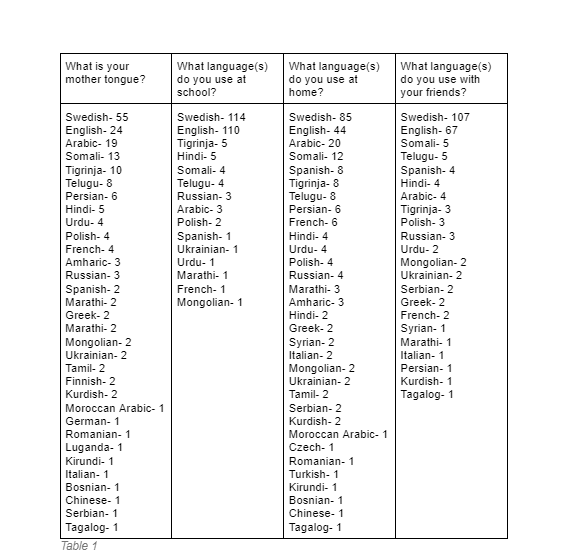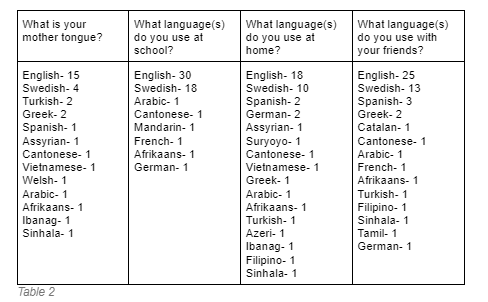Data Collection and Results
Research was gathered at this specific school setting from Year 4 students (roughly aged 9-11) and the staff working there. Both groups were asked the same questions which are as followed.
- What is your mother tongue?
- What language(s) do you use at school?
- What language(s) do you use at home?
- What language(s) do you use with your friends?
- At what age did you start learning these languages?
It was made clear to participants what a mother tongue language is and that it is possible to have more than one. They were also encouraged to include all languages they use for any kind of communication. If they know bits of a language but don’t use them (for example, knowing the first ten numbers in German), they were encouraged to not include them.
Below you can see the results from the Year 4 students in Table 1. It is divided by question, listing the language with the highest frequency first and the lowest frequency last. This table shows responses from 121 students. Not all students were present for the data collection and some results were inconclusive due to not fully filling it out and unclear answers.

Table 1 shows very clearly a variety of language repertoires in these students. The most interesting findings for me were that not all students listed English and Swedish as languages they use at school. Those are the two main working languages within the school and curriculum. All students have classes in both Swedish and English, though not all students feel they use those languages at school. For example, the student who wrote Marathi as their mother tongue, didn’t write that they use Swedish at school even though they have two classes fully in Swedish. This student hasn’t been in Sweden for very long so it suggests that they either don’t use or understand the language to the level of owning it as a language they use at school yet.
The next responses shown in Table 2 are from the staff at IES Sundbyberg. It includes the same questions asked to the Year 4 students and is organised in the same way. There were 30 responses.

There were very different answers compared to the Year 4s. For example, significantly less staff use Swedish at work, which I expected since most are not Swedish. The languages used at school are used for both communication between students and staff and also for teaching. The individual who included Cantonese and Mandarin in the languages used in school category said they only use them when helping students in their mother tongue lessons, but don’t use them anywhere else in the school. The individual who listed German in the same category is the German teacher at school and said they use it both in and out of the classroom with students on a daily basis.
Mother Tongue
As shown in the tables above, it’s apparent that there is a wide variety of mother tongues spoken at my school. According to Skolverket (The Swedish School Agency), access to mother tongue lessons is a right ( ). If a student wants to take mother tongue classes at school, the school must provide this for them. The students at my school usually have one mother tongue lesson a week either before or after their normal school schedule. This is the case even if only one student attends the lesson. They hire teachers who speak their mother tongue languages from an outside agency. Out of 142 Year 4 students, 103 of them attend mother tongue lessons. A breakdown of the language lessons and how many students attend them are listed below. Even with just Year 4 students, which make up around 16% of the school population, there are 28 mother tongue languages represented with those lessons.
- Arabic- 17
- Somali- 14
- Tigrinya- 12
- Telugu- 7
- Persian- 6
- Hindi- 5
- Russian- 4
- English- 4
- Urdu- 4
- Spanish- 3
- Polish- 3
- German- 2
- Kirundi- 2
- Tamil- 2
- Syrian- 2
- Aramaic- 2
- Armenian- 2
- French- 2
- Greek- 1
- Ukranian- 1
- Italian- 1
- Mongolian- 1
- Marathi- 1
- Romanian- 1
- Turkish- 1
- Bosnian- 1
- Serbian- 1
- Chinese- 1
Final Thoughts
I look forward to continuing to discover and understand multiculturalism within all aspects: in Sweden, in Stockholm, in Sundbyberg, in IES Sundbyberg, in Year 4, and at a class level. Although I knew our school staff and students are very diverse, it was eye opening to see in numbers just how diverse and multilingual we are as a school.
